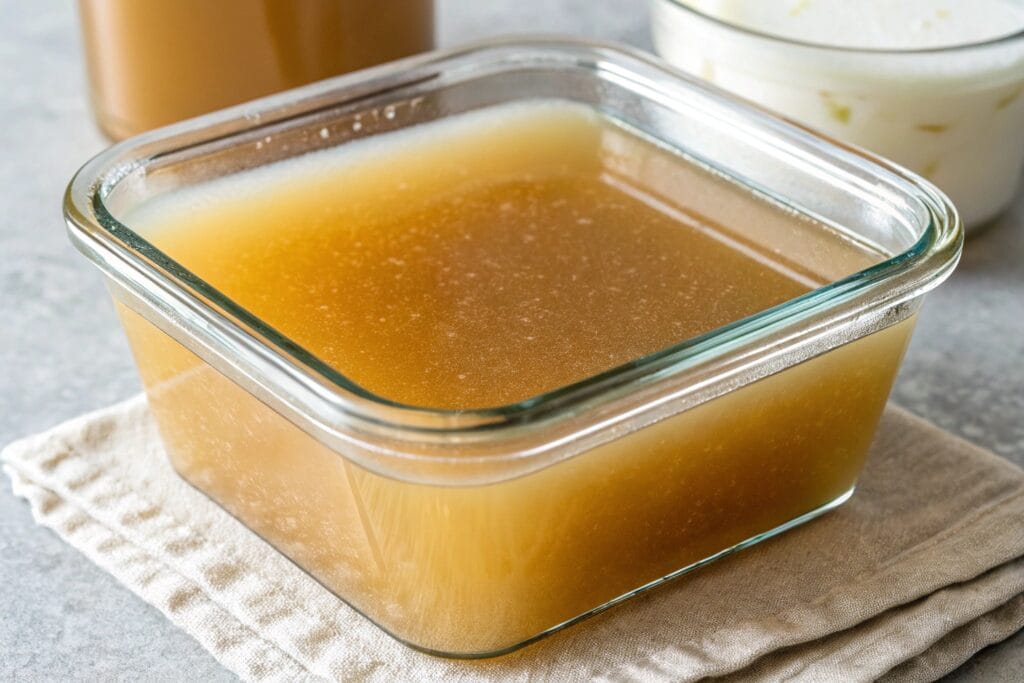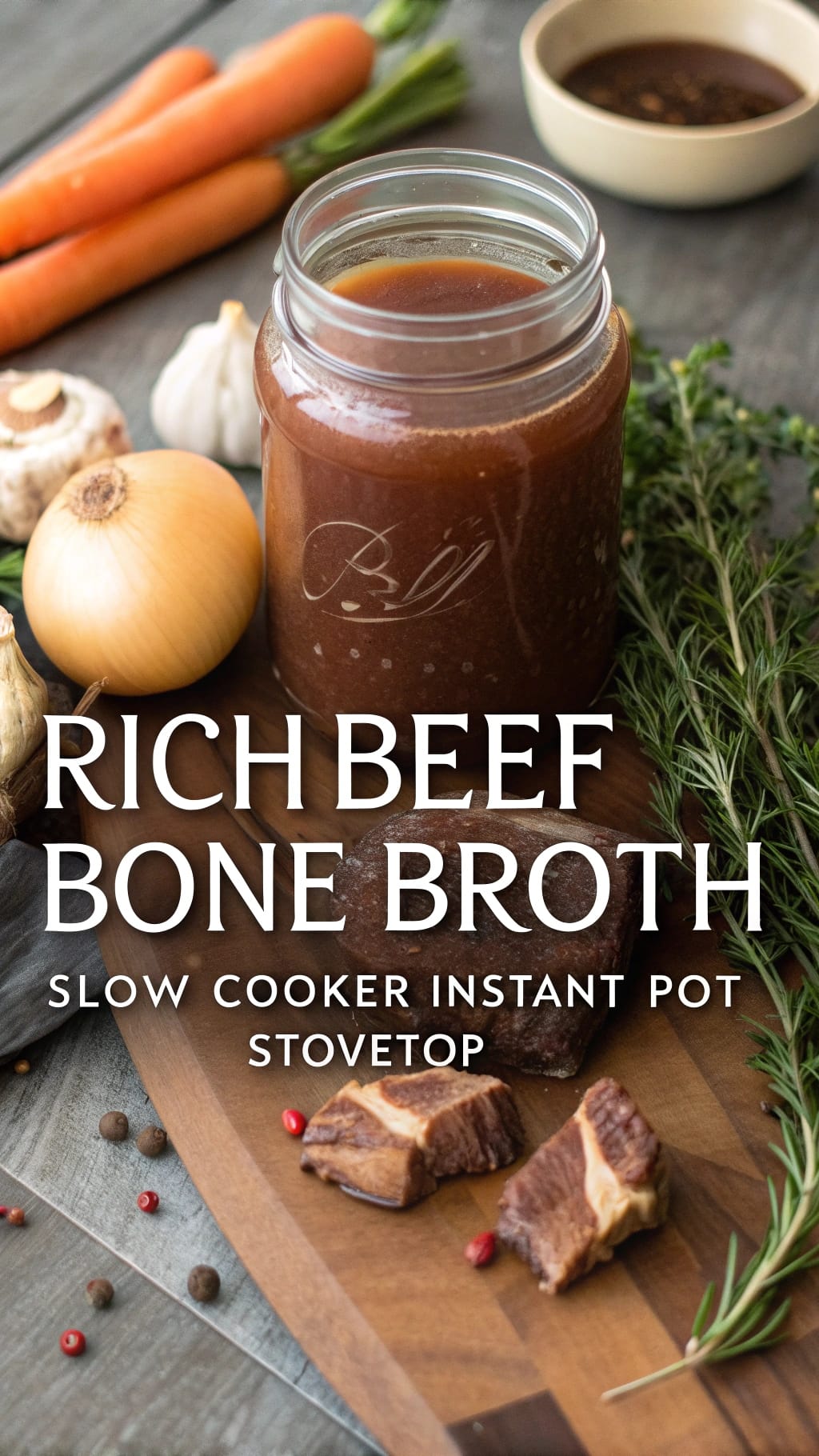How to Make Nutrient-Dense Beef Bone Broth (Keto & Carnivore Friendly)
There’s something almost magical about a pot of homemade beef bone broth simmering away in your kitchen. That deep, rich aroma that fills your home speaks to something primordial – a connection to traditional nourishment that modern food often lacks. For those following carnivore or keto lifestyles, bone broth isn’t just a comforting beverage; it’s a nutritional powerhouse that forms the foundation of optimal health.
Unlike the milder chicken bone broth, beef bone broth delivers a robust, intense flavor profile with remarkable depth. And while store-bought versions promise convenience, they simply cannot match the nutritional density and authentic taste of broth you’ve crafted yourself from quality bones.
In this comprehensive guide, I’ll walk you through creating the perfect beef bone broth three different ways – whether you prefer the “set it and forget it” approach of a slow cooker, the speed of an Instant Pot, or the traditional stovetop method. You’ll learn exactly which bones yield the most collagen, how to maximize flavor through proper roasting techniques, and the secret to achieving that perfect, jiggly gel that indicates a truly successful broth.
Table of Contents

Why Beef Bone Broth is a Keto/Carnivore Powerhouse (Benefits)
Collagen Power
Beef bones are particularly rich in Type I and Type III collagen – the most abundant collagen types in the human body. When slowly simmered, these bones release collagen that breaks down into gelatin, providing the building blocks your body needs for:
- Healthy skin elasticity and hydration
- Strong, flexible joints
- Resilient connective tissue throughout your body
- Gut lining support and repair
For carnivore and keto adherents who may not consume plant sources of certain amino acids, beef bone broth becomes even more valuable as a concentrated source of glycine, proline, and hydroxyproline – amino acids that are otherwise harder to obtain in sufficient quantities from muscle meat alone.
Mineral Richness
Quality beef bones, especially from grass-fed and finished animals, serve as nature’s mineral supplement, containing:
- Calcium and phosphorus for bone health
- Magnesium for hundreds of enzymatic processes
- Potassium for proper fluid balance
- Trace minerals that support metabolic function
These minerals leach into the broth during the cooking process, creating a bioavailable form that your body can easily absorb and utilize. The mineral content is notably superior when using bones from grass-fed cattle, whose diets naturally contain more diverse minerals than grain-fed counterparts.
Gut Healing Properties
Perhaps one of the most celebrated benefits of beef bone broth is its remarkable effect on digestive health. The gelatin and specific amino acids (especially glycine) support:
- Intestinal lining integrity
- Balanced stomach acid production
- Healthy gut microbiome environment
- Reduced inflammation throughout the digestive tract
Many following carnivore or keto approaches specifically for gut healing find that regular consumption of bone broth accelerates their progress and provides symptomatic relief.
Deep Savory Flavor & Satiety
Beyond nutritional benefits, beef bone broth delivers unmatched satisfaction through its natural umami richness. This deep savory quality makes it:
- A perfect standalone beverage between meals
- An appetite-regulating option during fasting periods
- A flavor foundation for carnivore/keto soups and sauces
- A satisfying way to increase mineral intake without excessive calories
Learn more about the differences between bone broth, stock, and regular broth
Discover the complete guide to the carnivore diet
Essential Ingredients for Rich Beef Bone Broth
Beef Bones (The Foundation)
Best Types for Flavor & Collagen (Approx. 3-4 lbs / 1.5-2 kg)
The secret to exceptional beef bone broth lies in using a variety of bones, each contributing different elements to the final product:
- Knuckle bones: Rich in collagen that creates the desirable gel
- Femur/marrow bones: Provide rich marrow fat and flavor
- Neck bones: Offer meat scraps that enhance taste
- Oxtail: Combines gelatinous tissue with incredible flavor
- Short rib bones: Supply fat, collagen and meaty essence
While you can make broth from any single type, a mixture of different bones creates the most complex and nutritionally complete result. For maximum collagen, ensure at least 30-40% of your bones are collagen-rich joints like knuckles and oxtail.
Marrow Bones: Liquid Gold
Marrow bones deserve special attention as they contribute the nutrient-dense bone marrow – a traditional superfood rich in quality fats and unique nutrients. The marrow:
- Adds luxurious mouthfeel to your broth
- Contains specialized stem cell stimulating compounds
- Provides fat-soluble vitamins (A, K2, D, E)
- Creates unmatched depth of flavor
Quality: Grass-Fed & Finished
While conventional bones will make broth, grass-fed and finished bones are worth seeking out because they:
- Contain better fatty acid profiles (higher omega-3 content)
- Have fewer accumulated toxins and hormones
- Provide superior vitamin and mineral content
- Support sustainable, humane farming practices
Check out the benefits of an animal-based diet
Water
Seemingly simple, your water choice does matter:
- Filtered water is preferred to remove chlorine and contaminants
- Use enough to cover bones by 1-2 inches initially
- Be prepared to add more during long simmers as evaporation occurs
Salt
Salt should be:
- Unrefined and mineral-rich (Redmond Real Salt, Celtic Sea Salt, or Himalayan)
- Added to taste, preferably toward the end of cooking
- Used conservatively if you plan to reduce the broth further
Apple Cider Vinegar (ACV) – Optional Add-in
While not strictly carnivore, a small amount of ACV is traditionally used to:
- Help extract minerals from the bones (1-2 tablespoons per batch)
- Add barely perceptible brightness to the deep flavor
- Potentially increase calcium content in the final broth
Note that while the scientific evidence for ACV’s extractive powers is limited, many traditional cooks swear by this addition. For strict carnivore adherents, this ingredient is completely optional and can be omitted without significantly impacting results.

The Secret to Deep Flavor: Roasting Your Beef Bones (Highly Recommended Step)
Unlike chicken bones, beef bones require proper roasting to reach their full flavor potential. This crucial step:
- Transforms potentially bland or slightly gamey flavors into rich, caramelized depth
- Creates appealing color through Maillard reactions
- Concentrates flavors before liquid dilution
- Renders surface fat for cleaner, clearer broth
How-To Roast Bones to Perfection:
- Preheat your oven to 400-425°F (200-220°C)
- Arrange bones in a single layer on a rimmed baking sheet
- Roast for 45-60 minutes, turning halfway through
- Look for deep golden-brown color (not burnt) as your indicator
- Optional flavor boost: In the final 10 minutes, you can brush bones with tomato paste (note: not strictly carnivore) for enhanced umami development
Don’t waste the flavorful drippings! After roasting, transfer the bones to your cooking vessel, then deglaze the roasting pan with a cup of hot water, scraping up all the browned bits. Add this concentrated flavor liquid to your broth pot.
How to Make Beef Bone Broth: Step-by-Step Methods
Method 1: Slow Cooker / Crock Pot (Deep Flavor Development)
The slow cooker method excels at gentle, consistent heat – perfect for extracting collagen without excessive evaporation.
- Place roasted bones in your slow cooker
- Add optional ACV (1-2 tablespoons) and let sit for 15-30 minutes
- Fill with enough filtered water to cover bones by 1-2 inches
- Set to LOW and cook for 24-72 hours (beef bones benefit greatly from extended cooking)
- Check occasionally, adding water if needed to keep bones submerged
- Skim any foam or impurities that rise to the surface during the first few hours
Pro tip: For beef bones specifically, 36-48 hours produces optimal collagen extraction and flavor development.
Method 2: Instant Pot / Pressure Cooker (Faster Option)
When time is limited, the pressure cooker method delivers remarkable results in a fraction of the time.
- Place roasted bones in your Instant Pot or pressure cooker
- Add optional ACV (1-2 tablespoons)
- Fill with water to cover bones, staying below the MAX fill line
- Seal and set to HIGH pressure for 3-4+ hours (minimum 180-240 minutes for beef)
- Allow for Natural Pressure Release (NPR) when finished – do not quick release
Note: While pressure cooking speeds the process dramatically, some connoisseurs believe extremely long simmers develop more complex flavors. If possible, use the maximum time setting on your device for beef bones.
Method 3: Stovetop (Maximum Control)
The traditional stovetop method offers complete control and observation throughout the process.
- Place roasted bones in a large stockpot
- Add optional ACV (1-2 tablespoons) and let sit for 15-30 minutes
- Fill with enough filtered water to cover bones by 2 inches
- Bring to a gentle boil, then immediately reduce to the lowest possible simmer
- Cook partially covered for 12-48+ hours
- Monitor regularly, skimming foam and adding water as needed
- Maintain the gentlest possible simmer – just a few bubbles breaking the surface
This method requires the most attention but allows you to adjust heat precisely and monitor the reduction process.
Final Step: Straining & Storing
Regardless of your cooking method, the final steps remain the same:
- Strain thoroughly: Using a fine-mesh strainer lined with cheesecloth for ultimate clarity
- Cool properly: Either in an ice bath (fastest) or in smaller containers in the refrigerator
- Defat if desired: After refrigeration, the solidified fat cap (tallow) on top can be easily removed and saved
Defatting & Saving the Tallow!
Don’t discard that beautiful layer of tallow! This nutrient-rich fat is perfect for:
- High-heat cooking (extremely stable)
- Adding to ground meat for moisture and flavor
- Using as a carnivore-friendly cooking medium
- Supporting skin health when used externally
Simply lift the solid fat cap off your chilled broth, melt it in a small pan over low heat, strain through cheesecloth, and store in a glass container.
Storage Options:
- Refrigerator: 5-7 days in glass containers
- Freezer: Up to 6 months in appropriate containers
- Use silicone molds for portion-sized cubes
- Leave headspace in glass containers to prevent cracking
- Consider reducing very gelatinous broth to save space, then diluting when used
Learn more about the relationship between carnivore diet and ketosis
Pro Tips for the BEST Beef Bone Broth
Achieving a Dark, Firm Gel
The coveted “jiggle” of properly made bone broth comes from:
- Using the right proportion of collagen-rich joint bones (knuckles, feet, oxtail)
- Not using excessive water (bones should barely be covered)
- Sufficient cooking time at appropriate temperature
- Proper cooling without dilution
If your first batch doesn’t gel firmly, don’t worry – it’s still nutritious! Simply adjust your bone selection and water ratio next time.
Getting Rid of “Funky” Flavor
Some beef bones, particularly from conventional sources, may have a slight off-flavor. Combat this by:
- Blanching raw bones before roasting: Cover with cold water, bring to boil for 10 minutes, discard water, rinse bones, then proceed with roasting
- Skimming diligently during the first hour of cooking
- Using aromatic vegetables in the final hour of cooking (note: not strictly carnivore)
- Ensuring bones are truly fresh, not previously frozen for extended periods
Storing & Using the Precious Tallow
The rendered fat from beef bones is a nutritional treasure:
- Store in glass containers in the refrigerator (lasts months)
- Use small portions for cooking at high temperatures
- Incorporate into ground meat dishes for added moisture and nutrients
- Blend a small amount into hot broth when serving for extra satiety
Re-Using Bones?
Yes, you can reuse beef bones for a second batch, though the results will be noticeably different:
- Second batches contain less collagen and minerals
- The color will be lighter and flavor less intense
- Consider adding one or two fresh marrow bones to boost the second batch
- Cooking time can be slightly shorter for second batches
Most dedicated broth makers find the optimal approach is using fresh bones for each batch and extending the cooking time rather than making multiple batches from the same bones.

How to Use Your Nutrient-Dense Beef Bone Broth
Sipping Plain
The simplest and often most therapeutic way to consume bone broth:
- Heat until steaming but not boiling
- Add extra unrefined salt to taste
- Drink from a mug as a between-meal boost
- Consider having 8-12oz upon waking or before bed
Base for Rich Keto/Carnivore Soups & Stews
Transform your broth into hearty meals:
- Keto Ground Beef Soup
- Use as the base for carnivore-friendly French onion soup (skip the bread and use extra cheese)
- Create simple egg drop soup by whisking eggs into hot broth
- Poach meat directly in simmering broth for tenderness
Making Rich Pan Sauces or Gravies
After cooking meat:
- Deglaze the pan with small amounts of bone broth
- Reduce the liquid by half while scraping up browned bits
- Whisk in cold tallow or butter for shine and body
- Season to taste for an instant gourmet sauce
Braising Liquid for Tougher Cuts of Meat
Bone broth transforms economical cuts:
- Use as the cooking liquid for pot roasts
- Braise short ribs or oxtail in bone broth
- Slow cook tough steaks submerged in broth
- Create tender pulled meat for carnivore meals
Try our Carnivore Ground Beef Recipe
Beef Bone Broth FAQ
Can I use beef soup bones from the grocery store?
Yes, standard grocery store beef soup bones will work, but with some considerations:
- They often include less collagen-rich parts than specialty butchers offer
- The animals are typically grain-finished, affecting nutrient content
- You may need to cook them longer for comparable results
- Consider adding extra joint bones if available
For best results, seek out bones from grass-fed sources, local farms, or specialty butchers who save these traditionally valued parts.
Why is my beef broth cloudy?
Cloudiness in bone broth typically results from:
- Boiling too vigorously (gentle simmer is key)
- Insufficient skimming during the first stage of cooking
- Not straining properly through fine mesh or cheesecloth
- Skipping the blanching step for raw bones
While cloudiness doesn’t affect nutrition, straining the completed broth through coffee filters can improve clarity if desired.
How is this different from the Carnivore Bone Broth recipe?
The main differences between this beef-specific recipe and our general Carnivore Bone Broth Recipe include:
- Strong emphasis on proper roasting (critical for beef, optional for other bones)
- Longer recommended cooking times (beef requires extended simmering)
- More focus on managing potential “off” flavors specific to beef
- Additional guidance on tallow preservation and usage
- Beef-specific bone selection advice

Conclusion
Homemade beef bone broth represents one of the most nutritionally dense and versatile additions to any carnivore or keto kitchen. Far more than a trendy beverage, it connects us to traditional wisdom about using whole animals respectfully and accessing nutrients that modern diets often lack.
The rich depth of flavor, impressive gelatin content, and mineral wealth make it worth the time investment – whether you choose the hands-off slow cooker method, the expedient pressure cooker approach, or the traditional stovetop technique.
As you integrate this liquid gold into your routine, you’ll likely notice improvements in digestion, joint comfort, and overall satiety. Plus, you’ll have the satisfaction of creating something genuinely nourishing from ingredients that might otherwise be discarded.
Have you made beef bone broth before? What’s your favorite way to use it? Share your experiences in the comments below, and don’t forget to save this guide for your next batch!
External Resources:
- NIH Study on Collagen Supplementation and Joint Health
- Weston A. Price Foundation on traditional bone broths
- American Grassfed Association standards for grass-fed beef
Enjoy, Review – We Value Your Opinion!
There are no reviews yet. Be the first one to write one.

